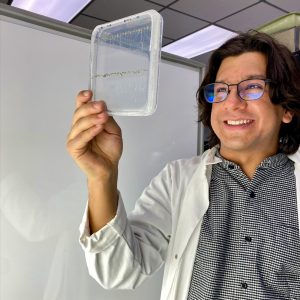Our colleagues Natalie Hoffmann and Eduardo Ramirez-Rodriquez won awards for their research on cell wall biosynthesis at the annual Canadian Society of Plant Biologists (CSPB) meeting, held virtually on Nov 27, 2021. Congratulations!
For plants, we often consider nutrients inside plant cells to be most important, but many fundamental materials come from the exterior wall of plant cells; products like wood, cotton, and biofuels. Graduate students Hoffmann and Ramirez-Rodriguez use two different approaches in the laboratory of Professor Heather McFarlane to understand how cell walls are made.

Hoffmann genetically disrupted manufacture of xyloglucan molecules important for cell wall formation during cell expansion. Components like xyloglucan are made inside the cell and transported to the exterior wall by a process called cell wall secretion. The cell wall secretion delivery system passes lipid-coated packages through endomembranes inside the cell, including a large sorting centre, the Golgi organelle. By integrating microscopic analysis with her genetic disruptions, Hoffmann’s award winning talk showed defects in many endomembrane components (including the Golgi), as if a mislabelled package had snarled the entire delivery system. Hoffmann used her “very visual” sensibilities to evocatively explain the fluorescent and electron microscope images in her talk titled “Alteration of xyloglucan biosynthesis disrupts endomembrane structure and function”.

Under salty or dry conditions, plants can grow to be twisted and stunted due to changes in the cell wall. Ramirez Rodriguez studies the protein changes that occur in plant cells under cell wall stress, including stress caused by herbicides. Cells under stress will change protein activity by adding phosphate molecules; these phosphorylation signals can result in the deformed plants seen in a dry, salty field. Ramirez-Rodriquez has isolated proteins that show phosphorylation changes under stress. By testing plants with genetically-encoded defects in his target proteins, he identified altered plants that show compromised cell wall integrity. He even describes one deformed seedling that looked like a pine cone! Knowing how his target proteins interact to cause phosphorylation has led to a deeper understanding of cell wall stress signalling in plants. His award winning poster was titled “Leveraging phosphoproteomics to uncover mechanisms of cell wall integrity signaling”.
The CSPB Eastern Regional Meeting brought together plant biology researchers from academic, government, and industry labs in Eastern Canada for a day of talks, posters, and networking. Hoffmann was eager to present, as it had been along time since her last talk. Sitting at home, Ramirez-Rodriquez was anxious that no visitors would appear at his virtual poster, but his chat and headphones reflected a steady stream of interest. Both Hoffmann and Ramirez-Rodriquez are grateful to CSPB and enjoyed the opportunity to virtually meet other plant scientists and learn about their struggles and accomplishments.
